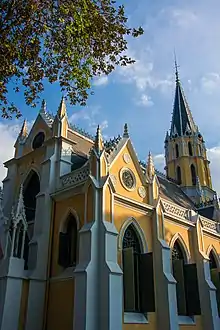Wat Niwet Thammaprawat
Wat Niwet Thammaprawat Ratchaworawihan (Thai: วัดนิเวศธรรมประวัติราชวรวิหาร) is a Buddhist temple (wat) of the Dhammayut Order, located within the grounds of the Bang Pa-In Royal Palace in Thailand's Phra Nakhon Si Ayutthaya Province. Founded in 1878, it is remarkable among Thai Buddhist temples in that its architecture mimics that of a European church, being built in the Gothic Revival style.
| Wat Niwet Thammaprawat | |
|---|---|
วัดนิเวศธรรมประวัติ | |
 | |
| Religion | |
| Affiliation | Buddhist |
| Sect | Dhammayut |
| Location | |
| Location | Mu 12, Ban Len Subdistrict, Bang Pa-in District, Phra Nakhon Si Ayutthaya Province, Thailand |
| Geographic coordinates | 14°13′53″N 100°34′34″E |
| Architecture | |
| Architect(s) | Joachim Grassi |
| Style | Gothic Revival |
| Founder | King Chulalongkorn |
| Groundbreaking | 1876 |
| Completed | 1878 |
History
The construction of Wat Niwet Thammaprawat was commissioned by King Chulalongkorn (Rama V) in 1876, to serve as the royal temple for the newly expanded Bang Pa-In Palace. The temple was designed by Joachim Grassi, one of the first Italian architects employed under the king's government. Many public buildings were built in the Western style during Chulalongkorn's reign, a trend reflecting the modernisation of Siam (as Thailand was then known) at the time. Wat Niwet Thammaprawat was built in Gothic Revival style, with stained glass windows and a Gothic altar. Its appearance resembles that of a Christian church, with the temple's main Buddha image in place of a Cross. Construction was completed in 1878.[1]
Status and location
Wat Niwet Thammaprawat is a royal temple, first-class, of the ratchaworawihan type, and is one of the sixteen temples which receive annual royal kathina offerings. It falls under the Dhammayut Order of Thai Theravada Buddhism.[2] It is a registered historic monument, and received the ASA Architectural Conservation Award in 1989.
The temple is located on an island of the Chao Phraya River, next to Bang Pa-in Royal Palace, in Ban Len Subdistrict, Bang Pa-in District, Phra Nakhon Si Ayutthaya Province. It is nowadays accessible by a cable car from the palace.[3]
See also
- Buddhism in Thailand
- Holy Redeemer Church, Bangkok - a Catholic church built in Thai style
References
- Maneenetra, Piti (31 January 2015). "The signification approach of decorative contents on Western buildings in Siamese Ornament and Decorative art revolution; A.D.1876-1896". Veridian E-Journal. Silpakorn University. 8 (4): 1–22. ISSN 1906-3431.
- อนันต์รัตนสุข, อนงค์ (20 September 2012). "องค์ความรู้เรื่องประวัติวัดนิเวศธรรมประวัติราชวรวิหาร" (pdf) (in Thai). Ayutthaya Provincial Cultural Office. Retrieved 23 June 2016.
- "วัดนิเวศธรรมประวัติ ราชวรวิหาร จ.พระนครศรีอยุธยา". Dhammathai.org. Retrieved 23 June 2016.
External links
 Media related to Wat Niwet Thammaprawat at Wikimedia Commons
Media related to Wat Niwet Thammaprawat at Wikimedia Commons